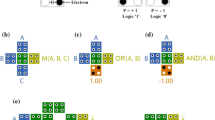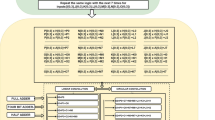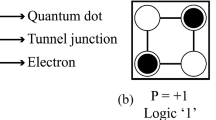Abstract
In the digital design area, quantum-dot cellular automata (QCA) has become a promising alternative to the CMOS technology. As a basic unit in digital arithmetic circuits, the full adder has been extensively studied in the development of QCA technology. This paper presents two novel full adder implementations using QCA, which outperform other designs with fewer cells, smaller areas, shorter latency and lower cost. The two full adders share many properties in common and differ only in cell numbers. Concretely speaking, a latency of 0.75 clock cycle, area of 0.01 μm2 and cost weighted 0.0056 is implemented using only 28 and 31 normal cells, respectively. To illustrate the superiority of our design in complex structures, ripple carry adder circuits of 4-bit, 8-bit and 16-bit size have been implemented using the proposed 1-bit full adder. Simulation results show that the proposed design also has good stability and scalability in different circuit size, resulting in significant improvements in terms of number of cells, area, cost compared to designs in other studies, while maintaining an equally well clock latency with the best previous one. The proposed designs in this paper have been functionally verified with the QCADesigner tool.



















Similar content being viewed by others
References
Lent CST, Douglas P, Bernstein Gary H (1993) Quantum cellular automata. Nanotechnology 4:49–57
Lent CS, Tougaw PD (1997) A device architecture for computing with quantum dots. Proc IEEE 85(4):541–557. https://doi.org/10.1109/5.573740
Orlov AO, Amlani I, Bernstein GH, Lent CS, Snider GL (1997) Realization of a functional cell for quantum-dot cellular automata. Science 277(5328):928–930
Amlani I, Orlov AO, Kummamuru RK, Bernstein GH (2000) Experimental demonstration of a leadless quantum-dot cellular automata cell. Appl Phys Lett 77(5):738–740
Rumi Z, Walus K, Wei W, Jullien GA (2004) A method of majority logic reduction for quantum cellular automata. IEEE Trans Nanotechnol 3(4):443–450. https://doi.org/10.1109/TNANO.2004.834177
Navi K, Sayedsalehi S, Farazkish R, Azghadi MR (2010) Five-input majority gate, a new device for quantum-dot cellular automata. J Comput Theor Nanosci 7(8):1–8
Tougaw PD, Lent CS (1994) Logical devices implemented using quantum cellular automata. J Appl Phys 75(3):1818–1825
Gin A, Tougaw PD, Williams S (1999) An alternative geometry for quantum-dot cellular automata. J Appl Phys 85(12):8281–8286
Wang W, Walus K, Jullien GA (2003) Quantum-dot cellular automata adders. In: 2003 Third IEEE Conference on Nanotechnology, 2003. IEEE-NANO 2003, vol 462, pp 461–464
Hanninen I, Takala J (2007) Robust adders based on quantum-dot cellular automata. IEEE Int Conf Asap. https://doi.org/10.1109/asap.2007.4459295
Mohammadi M, Mohammadi M, Gorgin S (2016) An efficient design of full adder in quantum-dot cellular automata (QCA) technology. Microelectron J 50(Supplement C):35–43. https://doi.org/10.1016/j.mejo.2016.02.004
Labrado C, Thapliyal H (2016) Design of adder and subtractor circuits in majority logic-based field-coupled QCA nanocomputing. Electron Lett 52(6):464–465. https://doi.org/10.1049/el.2015.3834
Seyedi S, Navimipour NJ (2018) An optimized design of full adder based on nanoscale quantum-dot cellular automata. Optik Int J Light Electron Opt 158:243–256
Sayedsalehi SMMH, Navi K (2011) Novel efficient adder circuits for quantum-dot cellular automata. J Comput Theor Nanosci 8(9):1769–1775
Sarmadi S, Sayedsalehi S, Fartash M, Angizi S (2015) A structured ultra-dense QCA one-bit full-adder cell. Quantum Matter 4(1):125–130
Liu W, Lu L, Neill MO, Swartzlander EE (2011) Design rules for quantum-dot cellular automata. In: 2011 IEEE International Symposium of Circuits and Systems (ISCAS), 15–18 May 2011, pp 2361–2364. https://doi.org/10.1109/iscas.2011.5938077
Walus K, Dysart TJ, Jullien GA, Budiman RA (2004) QCADesigner: a rapid design and simulation tool for quantum-dot cellular automata. IEEE Trans Nanotechnol 3(1):26–31. https://doi.org/10.1109/TNANO.2003.820815
Cho H, Swartzlander EE (2007) Adder designs and analyses for quantum-dot cellular automata. IEEE Trans Nanotechnol 6(3):374–383. https://doi.org/10.1109/TNANO.2007.894839
Heikalabad SR, Asfestani MN, Hosseinzadeh M (2017) A full adder structure without cross-wiring in quantum-dot cellular automata with energy dissipation analysis. J Supercomput. https://doi.org/10.1007/s11227-017-2206-4
Hashemi S, Tehrani MA, Navi K (2012) An efficient quantum-dot cellular automata full-adder. Sci Res Essays 7(2):177–189
Navi K, Farazkish R, Sayedsalehi S, Rahimi Azghadi M (2010) A new quantum-dot cellular automata full-adder. Microelectron J 41(12):820–826. https://doi.org/10.1016/j.mejo.2010.07.003
Hänninen I, Takala J (2010) Binary adders on quantum-dot cellular automata. J Signal Process Syst 58(1):87–103
Acknowledgements
The authors would like to acknowledge National Natural Science Foundation of China (No. 61271122).
Author information
Authors and Affiliations
Corresponding author
Rights and permissions
About this article
Cite this article
Wang, L., Xie, G. Novel designs of full adder in quantum-dot cellular automata technology. J Supercomput 74, 4798–4816 (2018). https://doi.org/10.1007/s11227-018-2481-8
Published:
Issue Date:
DOI: https://doi.org/10.1007/s11227-018-2481-8




